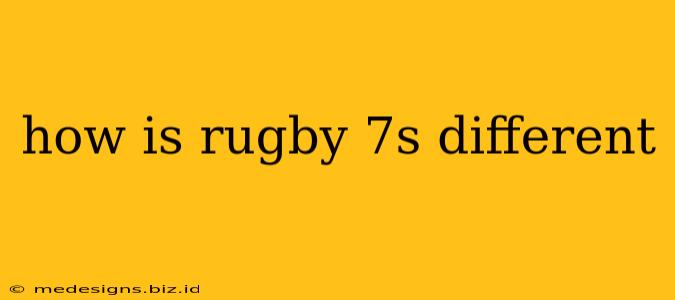How is Rugby Sevens Different from Rugby Union? A Comprehensive Guide
Rugby sevens and rugby union, while both stemming from the same family of rugby football, offer vastly different playing experiences. Understanding these key differences is crucial for appreciating the unique challenges and thrills of each. This guide will break down the core distinctions, covering everything from gameplay to strategy.
Key Differences: A Quick Overview
Before diving into the details, here's a quick summary of the most significant differences between rugby sevens and rugby union:
- Number of Players: The most obvious difference: sevens uses seven players per team, while union utilizes fifteen.
- Game Length: Sevens matches are significantly shorter, resulting in a faster, more intense game.
- Game Structure: The shorter game time leads to a more condensed and attacking style of play.
- Fitness Demands: Sevens demands explosive speed, incredible stamina, and unmatched agility.
- Strategic Approaches: Game plans and strategic approaches differ drastically due to the reduced number of players.
1. The Number of Players: A Game Changer
This fundamental difference dictates almost every other aspect of the game. In rugby union, the larger number of players allows for a more complex and structured game, with defined roles and positions. Rugby sevens, with only seven players, demands versatility and all-round athleticism. Every player needs to be capable of attacking, defending, and contributing to the breakdown.
2. Game Length and Pace: Fast and Furious vs. Strategic and Tactical
Rugby sevens matches are divided into two seven-minute halves, with a short break between them. This short timeframe creates an incredibly fast-paced, high-intensity game. Rugby union, on the other hand, features two 40-minute halves, allowing for a more strategic and tactical approach with periods of both high intensity and controlled play.
3. Game Structure: Constant Attack vs. Calculated Maneuvers
The shorter game length in rugby sevens encourages a more continuous and attacking style of play. There's less time for structured phases of play, leading to more open, running rugby. Rugby union allows for more complex attacking patterns, mauls, scrums and lineouts, giving teams more time to build their attacks methodically.
4. Fitness Demands: Explosive Power vs. Stamina and Strength
Rugby sevens requires players to possess exceptional explosive power, speed, and stamina. Players need to sprint, tackle, and support attacks throughout the entire match, with very little time to rest. Rugby union still demands high levels of fitness, but with more variation in intensity. While stamina is important, players can often find brief periods of respite during phases of play.
5. Strategic Approaches: Adaptability and Versatility are Key
The strategic aspects of both sports differ greatly. Rugby sevens requires adaptability and quick thinking on the field. Teams need to exploit any gaps in the defense immediately, as opportunities are fleeting. Rugby union allows for more intricate game plans, with different strategies employed based on opposition strengths and weaknesses.
Conclusion: Two Sides of the Same Coin
While distinct in their gameplay, both rugby sevens and rugby union share a common heritage and a similar core set of values. Understanding the key differences allows fans to fully appreciate the unique strengths and challenges of each format, recognizing the intense athleticism and strategic brilliance required to excel in either code. Whether you prefer the frenetic pace of sevens or the strategic depth of union, both games offer compelling displays of skill, strength, and sportsmanship.
